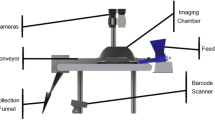Abstract
Potato tuber length to width (L/W) ratio is an indicator of shape phenotype, which is an important quality trait assessed in breeding and variety development. The standard method of measurement using calipers is labor intensive and time consuming. In this study, an image acquisition system was integrated with an automated potato sizer to capture video data of tubers during sorting for estimation of L/W ratios. An algorithm was developed to segment and estimate the L/W ratios from the video frame in an accurate and high-throughput manner. Line profile was used to determine the tuber position in the frame. The minimal bounding rectangle of each tuber was computed to estimate length and width of the tubers. The imaging conditions (light, imaging distance, and speed) were optimized using fresh market potato tubers (43 samples). Finally, the algorithm was tested with eight sets of field samples of tubers of cultivars Bondi and Alturas (about 709–1273 samples/set). Optimization results indicated that L/W measurement accuracy was higher than 95% for the fresh market potato tubers, with no significant effect of tested imaging conditions. There was also a significant correlation between ground-truth caliper measurements and image-based data (Pearson’s correlation coefficient: 0.84–0.99, p < 0.01). The accuracies of L/W estimations for field samples of Bondi and Alturas tubers ranged from 76 to 100%. The lower accuracies are likely attributed to differences in sample size. Nevertheless, the method is applicable for rapid and accurate estimation of L/W ratio for a large set of samples .




Similar content being viewed by others
References
R.J. Hijmans, Global distribution of the potato crop. Am. J. Potato Res. 78(6), 403–412 (2001)
J. Lang, Notes of a Potato Watcher (No. 4). (International Potato Center, Lima, 2001)
C.N. Hirsch, C.D. Hirsch, K. Felcher, J. Coombs, D. Zarka, A. Van Deynze, D.S. Douches, (2013). Retrospective view of North American potato (Solanum tuberosum L.) breeding in the 20th and 21st centuries. G3: Genes Genomes Genet. 3(6), 1003–1013
A.M. Rady, D.E. Guyer, Rapid and/or nondestructive quality evaluation methods for potatoes: a review. Comput. Electron. Agric. 117, 31–48 (2015)
D. Fajardo, K.G. Haynes, S. Jansky, Starch characteristics of modern and heirloom potato cultivars. Am. J. Potato Res. 90(5), 460–469 (2013)
H.J. Van Eck, J.M. Jacobs, P. Stam, J. Ton, W.J. Stiekema, E. Jacobsen, Multiple alleles for tuber shape in diploid potato detected by qualitative and quantitative genetic analysis using RFLPs. Genetics 137(1), 303–309 (1994)
Y. Tao, C.T. Morrow, P.H. Heinemann, H.J. Sommer, Fourier-based separation technique for shape grading of potatoes using machine vision. Trans. ASAE 38(3), 949–957 (1995)
J. Śliwka, I. Wasilewicz-Flis, H. Jakuczun, C. Gebhardt, Tagging quantitative trait loci for dormancy, tuber shape, regularity of tuber shape, eye depth and flesh colour in diploid potato originated from six Solanum species. Plant Breed. 127(1), 49–55 (2008)
A. Prashar, C. Hornyik, V. Young, K. McLean, S.K. Sharma, M.F.B. Dale, G.J. Bryan, Construction of a dense SNP map of a highly heterozygous diploid potato population and QTL analysis of tuber shape and eye depth. Theor. Appl. Genet. 127(10), 2159–2171 (2014)
M.J.H. Keijbets, Potato processing for the consumer: developments and future challenges. Potato Res. 51(3–4), 271–281 (2008)
H. Lindqvist-Kreuze, A. Khan, E. Salas, S. Meiyalaghan, S. Thomson, R. Gomez, M. Bonierbale, Tuber shape and eye depth variation in a diploid family of Andean potatoes. BMC Genet. 16(1), 1 (2015)
M.J. Pavek, N.R. Knowles, Potato cultivar yield and postharvest quality evaluations for 2015. Washington State University Special Report. http://potatoes.wsu.edu/wp-content/uploads/2016/01/Potato-Cultivar-Yield-and-Postharvest-Quality-Evaluations-Research-Edition-2015.pdf. p. 114 (2015)
R. Hasankhani, H. Navid, Potato sorting based on size and color in machine vision system. J. Agric. Sci. 4(5), 235 (2012)
J.A. Marchant, C.M. Onyango, M.J. Street, Computer vision for potato inspection without singulation. Comput. Electron. Agric. 4(3), 235–244 (1990)
R. Rios-Cabrera, I. Lopez-Juarez, H. Sheng-Jen, ANN analysis in a vision approach for potato inspection. J. Appl. Res. Technol. 6(2), 106–117 (2008)
G. ElMasry, S. Cubero, E. Moltó, J. Blasco, In-line sorting of irregular potatoes by using automated computer-based machine vision system. J. Food Eng. 112(1), 60–68 (2012)
N. Razmjooy, B.S. Mousavi, F. Soleymani, A real-time mathematical computer method for potato inspection using machine vision. Comput. Math. Appl. 63(1), 268–279 (2012)
Y. Si, S. Sankaran, N.R. Knowles, M.J. Pavek, Potato tuber length-width ratio assessment using image analysis. Am. J. Potato Res. 94(1), 88–93 (2017)
N. Otsu, A threshold selection method from gray-level histograms. Automatica 11, 285–296 (1975)
L. Zhou, V. Chalana, Y. Kim, PC-based machine vision system for real-time computer-aided potato inspection. Int. J. Imaging Syst. Technol. 9(6), 423–433 (1998)
J.C. Noordam, G.W. Otten, T.J. Timmermans, B.H. van Zwol, High-speed potato grading and quality inspection based on a color vision system. In Proceedings SPIE Volume 3966, Machine Vision Applications in Industrial Inspection VII, pp. 206–217 (2000). https://doi.org/10.1117/12.380075
M. Barnes, T. Duckett, G. Cielniak, Boosting minimalist classifiers for blemish detection in potatoes. In Image and Vision Computing New Zealand, 2009. IVCNZ’09. 24th International Conference, IEEE, pp. 397–402 (2009)
W. Chenglong, L. Xiaoyu, W. Wei, L. Jie, T. Hailong, W. Dongdong, Detection of potato’s size based on centroidal principal axis. Afr. J. Agric. Res. 6(17), 4140–4148 (2011)
Acknowledgements
This research was funded, in part, by the USDA National Institute of Food and Agriculture, Hatch Project, 1002864 (WNP00821) and by the program of study abroad for young teachers sponsored by the Agricultural University of Hebei.
Author information
Authors and Affiliations
Corresponding author
Rights and permissions
About this article
Cite this article
Si, Y., Sankaran, S., Knowles, N.R. et al. Image-based automated potato tuber shape evaluation. Food Measure 12, 702–709 (2018). https://doi.org/10.1007/s11694-017-9683-2
Received:
Accepted:
Published:
Issue Date:
DOI: https://doi.org/10.1007/s11694-017-9683-2




